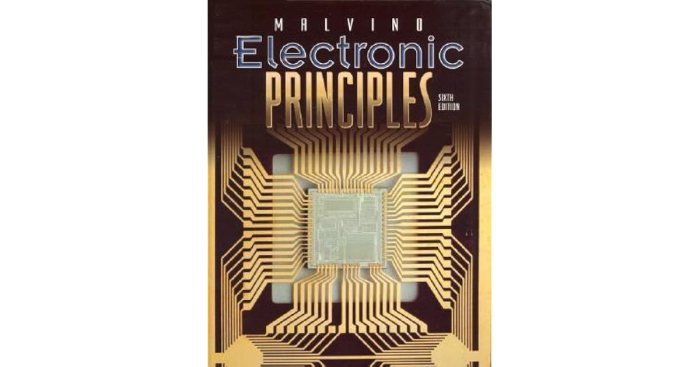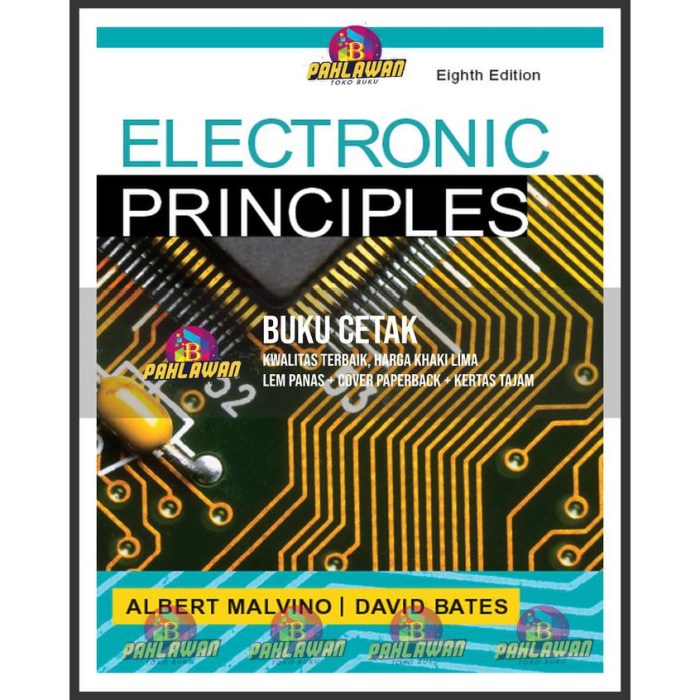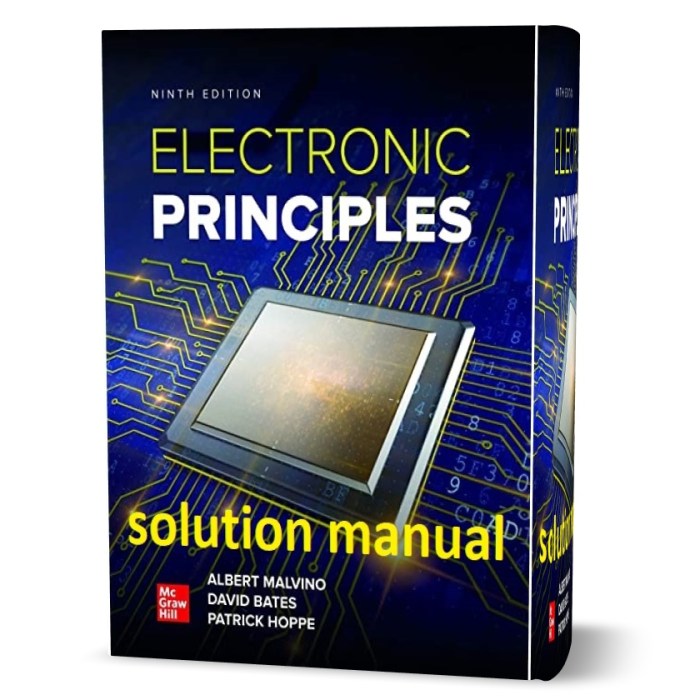Introducing the electronic principles albert malvino solution, a comprehensive resource that empowers students and professionals alike to delve into the intricacies of electronics. This solution manual provides a profound understanding of the fundamental concepts, applications, and troubleshooting techniques that underpin this dynamic field.
Albert Malvino’s renowned textbook, “Electronic Principles,” has shaped generations of electronics enthusiasts and practitioners. This solution manual serves as an invaluable companion, offering step-by-step guidance through the text’s challenging problems and exercises.
Electronic Principles

Electronic principles encompass the fundamental concepts, components, laws, and theorems that govern the behavior of electrical circuits and electronic systems. These principles form the foundation for understanding and designing electronic devices, from simple circuits to complex integrated systems.
Key concepts in electronic principles include the study of electricity, magnetism, semiconductors, and circuit analysis. Students learn about the properties of electrical components such as resistors, capacitors, inductors, and transistors, and how they can be combined to create functional circuits.
Electronic principles also cover the basic laws and theorems that govern electrical circuits, such as Ohm’s law, Kirchhoff’s laws, and the Thevenin and Norton theorems. These laws provide a framework for analyzing and predicting the behavior of circuits under various conditions.
Examples of Electronic Components and Their Functions
- Resistors: Control the flow of current in a circuit.
- Capacitors: Store electrical energy and release it when needed.
- Inductors: Store magnetic energy and oppose changes in current.
- Transistors: Amplify or switch electrical signals.
- Diodes: Allow current to flow in only one direction.
Basic Laws and Theorems Governing Electrical Circuits
- Ohm’s law: V = IR (Voltage = Current × Resistance)
- Kirchhoff’s current law: The total current entering a junction is equal to the total current leaving the junction.
- Kirchhoff’s voltage law: The sum of the voltages around a closed loop in a circuit is equal to zero.
- Thevenin’s theorem: Any linear circuit can be replaced by an equivalent voltage source and series resistor.
- Norton’s theorem: Any linear circuit can be replaced by an equivalent current source and parallel resistor.
Albert Malvino

Albert Paul Malvino (1927-2018) was a renowned educator and author in the field of electronics. He made significant contributions to electronics education through his widely-used textbooks and innovative teaching methods.
Malvino believed in a hands-on approach to learning, emphasizing the importance of practical experience and problem-solving skills. He developed a unique teaching style that combined theoretical concepts with real-world applications.
Malvino’s most notable work is the textbook “Electronic Principles,” which has been used by generations of students and professionals in the field of electronics. The textbook provides a comprehensive introduction to electronic principles, covering a wide range of topics from basic concepts to advanced applications.
Role in Developing the Textbook “Electronic Principles”
Malvino’s textbook “Electronic Principles” was first published in 1973 and has since become a standard reference for students and professionals in the field of electronics. The textbook is known for its clear and concise explanations, numerous examples, and practical applications.
Malvino’s approach to writing “Electronic Principles” was to present the material in a logical and accessible manner, focusing on the fundamental principles of electronics and their practical applications. The textbook has been updated regularly to keep pace with the latest advancements in electronics technology.
Solution Manual: Electronic Principles Albert Malvino Solution
The solution manual for “Electronic Principles” by Albert Malvino provides step-by-step solutions to the end-of-chapter problems and exercises. The manual is designed to help students understand the concepts and principles presented in the textbook and to develop their problem-solving skills.
The solution manual covers a wide range of problems, from basic exercises to more complex design challenges. The solutions are clear and detailed, providing students with a thorough understanding of the problem-solving process.
Types of Problems and Exercises Covered in the Manual
- Basic circuit analysis problems
- Troubleshooting exercises
- Design challenges
- Simulation problems
- Case studies
Applications

Electronic principles find applications in a wide variety of fields, including:
- Consumer electronics (e.g., smartphones, televisions, computers)
- Industrial automation (e.g., robotics, process control)
- Medical devices (e.g., pacemakers, imaging systems)
- Transportation (e.g., automotive electronics, avionics)
- Communications (e.g., telecommunications, wireless networks)
Electronic principles are essential for the design and development of these and many other technologies that impact our daily lives.
Role of Electronics in Modern Technologies
Electronics play a crucial role in modern technologies by enabling:
- Communication over long distances
- Automated processes and control systems
- Advanced medical treatments and diagnostics
- Efficient energy management
- Enhanced entertainment and educational experiences
Troubleshooting
Troubleshooting is the process of identifying and resolving problems in electronic circuits. It involves a systematic approach to testing and isolating the faulty component or connection.
Basic troubleshooting principles include:
- Visual inspection for loose connections or damaged components
- Voltage and continuity testing to verify proper circuit operation
- Signal tracing to identify the source of a problem
- Replacement of faulty components
Step-by-Step Guide to Troubleshooting Electronic Circuits
- Gather necessary tools and equipment (e.g., multimeter, oscilloscope)
- Identify the symptoms of the problem
- Perform a visual inspection
- Test voltages and continuity
- Trace signals through the circuit
- Replace faulty components
- Retest the circuit
Design Considerations

When designing electronic circuits, it is important to consider factors such as:
- Component selection
- Circuit layout
- Power consumption
- Signal integrity
- Electromagnetic compatibility (EMC)
- Testability and maintainability
Guidelines for Designing Electronic Circuits
- Use appropriate components for the intended application
- Layout the circuit to minimize noise and interference
- Minimize power consumption to extend battery life or reduce operating costs
- Ensure signal integrity by considering factors such as impedance matching and signal routing
- Design for EMC to prevent interference with other electronic devices
- Include test points and diagnostic features to facilitate troubleshooting
Further Exploration
For further study in electronics, consider the following resources:
- Online tutorials and simulations
- Electronics textbooks and reference materials
- Electronics courses and workshops
- Electronics project ideas and inspiration
Exploring these resources can help you deepen your understanding of electronic principles and develop your skills in electronics design and troubleshooting.
Career Opportunities in the Field of Electronics, Electronic principles albert malvino solution
Electronics is a rapidly growing field with numerous career opportunities. Some common career paths include:
- Electronics engineer
- Electronics technician
- Circuit designer
- Product development engineer
- Technical support specialist
Answers to Common Questions
What is the purpose of the electronic principles albert malvino solution?
The electronic principles albert malvino solution provides step-by-step guidance through the challenging problems and exercises found in Albert Malvino’s renowned textbook, “Electronic Principles.”
Who can benefit from using this solution manual?
Students, educators, and professionals in the field of electronics can all benefit from using this solution manual.
What types of problems and exercises are covered in the solution manual?
The solution manual covers a wide range of problems and exercises, including those involving basic circuit analysis, transistor circuits, operational amplifiers, and digital electronics.